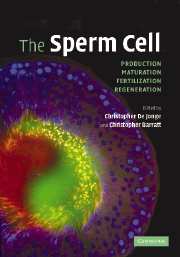Book contents
- Frontmatter
- Contents
- Preface
- List of contributors
- 1 Mammalian spermatogenesis and sperm structure: anatomical and compartmental analysis
- 2 Sperm chromatin stability and susceptibility to damage in relation to its structure
- 3 Genomic and proteomic approaches to defining sperm production and function
- 4 Sperm maturation in the human epididymis
- 5 Controls of sperm motility
- 6 Regulation of capacitation
- 7 Reactive oxygen species: friend or foe
- 8 Testing sperm manufacturing quality: the sperm–zona binding assay
- 9 Genetics: a basic science perspective
- 10 Sex chromosome abnormalities and male infertility: a clinical perspective
- 11 Epigenetic patterning in male germ cells: importance of DNA methylation to progeny outcome
- 12 The DAZ gene family and human germ cell development from embryonic stem cells
- Index
1 - Mammalian spermatogenesis and sperm structure: anatomical and compartmental analysis
Published online by Cambridge University Press: 14 August 2009
- Frontmatter
- Contents
- Preface
- List of contributors
- 1 Mammalian spermatogenesis and sperm structure: anatomical and compartmental analysis
- 2 Sperm chromatin stability and susceptibility to damage in relation to its structure
- 3 Genomic and proteomic approaches to defining sperm production and function
- 4 Sperm maturation in the human epididymis
- 5 Controls of sperm motility
- 6 Regulation of capacitation
- 7 Reactive oxygen species: friend or foe
- 8 Testing sperm manufacturing quality: the sperm–zona binding assay
- 9 Genetics: a basic science perspective
- 10 Sex chromosome abnormalities and male infertility: a clinical perspective
- 11 Epigenetic patterning in male germ cells: importance of DNA methylation to progeny outcome
- 12 The DAZ gene family and human germ cell development from embryonic stem cells
- Index
Summary
Detailed theoretical analysis, using mathematical modeling, reveals that sex is a very inefficient way of reproducing. The inefficiency lies in making male offspring. In the majority of sexual species, only the female contributes energy and resources to the young. In contrast the males rarely contribute more than the minimum-a tiny sperm carrying genes, but devoid of other resources.
The Evolution of Life, edited by Linda Gamlin and Gail Vanes, Oxford University Press, New York, 1987Introduction
What is said above argues that the male contribution at fertilization is restricted to one half of future embryonic chromosomes. Although inspired by general perception and often perpetuated by popular science, this assumption is incorrect. Besides being a launching pad for the remaining chapters of this tome, the goal of the present chapter is to demonstrate that the male germ cell, the spermatozoon, is well suited to make other important contributions to the zygote and embryo. Studying spermatogenesis allows us to show how the unique, paternally contributed resources are generated during the intricate and fascinating process of spermatogenesis. In a show of male vanity, we decided to take a somewhat unconventional approach to this treatise on spermatogenesis and sperm structure by putting the emphasis of paternal contributions made at fertilization. We thus focus mainly on the later stages of spermatogenesis, during which the haploid, somatic-cell like round spermatid is transformed into a specialized, nearly cytoplasm-free spermatozoon capable of acquiring progressive motility and fertilizing an ovum in the oviductal environment.
- Type
- Chapter
- Information
- The Sperm CellProduction, Maturation, Fertilization, Regeneration, pp. 1 - 30Publisher: Cambridge University PressPrint publication year: 2006
- 10
- Cited by



